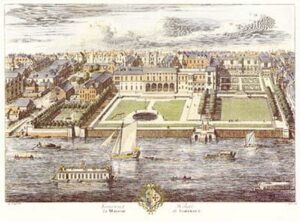
On this day in history, the 30th July 1553, Princess Elizabeth left her new home, Somerset House, to ride to Wanstead and greet her half-sister, Mary, England’s new queen.
Princess Elizabeth had moved into Somerset House, a house just off The Strand, on the north bank of the River Thames, just the previous day. Mary had been proclaimed Queen Mary I on the 19th July in London and Elizabeth, who had been at Hatfield when she heard the news, rode to London, entering the city on the 29th July through Fleet Street and on to her new townhouse, or rather palace, Somerset House.
Somerset House
Somerset House was the former home of Edward Seymour, the 1st Duke of Somerset and former Lord Protector. After Somerset’s fall and subsequent execution in 1552, John Dudley, the Earl of Northumberland and new leader of Edward VI’s Regency Council, offered Somerset House to Elizabeth in return for her acquiescence to him taking Durham Place, Elizabeth’s townhouse.
Somerset House was built by Edward Seymour, Protector Somerset, between 1547-50 using stone scavenged from the charnel house of St Paul’s Cathedral. It had cost him £10,000 to build and was built in a Renaissance style. The Somerset House website says of it:-
“Although it was a courtyard house in the Tudor tradition, with a gatehouse to the Strand and a great hall opposite on the river front, the Strand facade departed from the old Gothic style of architecture and, instead, combined Doric and Ionic pillars in the most serious attempt at classical composition yet seen in England.”
It is not known who Somerset used as architect, although it is thought to be either John Thynne or John of Padua.

Even though the house had only been completed in 1550 and Somerset had not exactly used it much, David Starkey writes that £900 was spent on preparing the house for its new royal mistress in 1553. Starkey also points out that the keeper of the house was no other than Robert Dudley, Northumberland’s son and Elizabeth’s childhood friend. On her accession in November 1558, Elizabeth (now Queen Elizabeth I) spent a week in the royal apartments of the Tower of London, before returning home to Somerset House. However, on the 23rd December 1558, the Queen moved to Whitehall Palace and this became her principal residence. From then on, Somerset House tended to be used as a lodging house for visiting foreign diplomats and for the odd council meeting.
Somerset House from the Stuarts until 1775
During the reign of James I, Elizabeth’s successor, Somerset House became the home of Anne of Denmark, James’s wife. The house was renamed “Denmark House” and Anne hosted lavish entertainments at her home, focusing particularly on the English Masque, helped by Ben Jonson and Inigo Jones. As well as designing sets for masques, Jones was the architect used by Anne for the major building work she started in 1609. £34,500 was spent on building new buildings and remodelling others. 1625 saw the accession of Charles I to the throne and Somerset House/Denmark House became the home of his wife, Henrietta Maria of France. Inigo Jones was again involved in improvements to the house and gardens, including the building of a new chapel for the Queen.
In the Civil War, the house was used by General Fairfax as his quarters and it was also used to store the seized royal treasures while they were inventoried before being sold. In 1658 Somerset House was the place where Oliver Cromwell’s body lay in state. After the Civil War and Charles II’s Restoration, the house became a royal residence again as the Queen Dowager, Henrietta Maria, moved back into the house and started on a programme of rebuilding work. However, the plague of 1665 caused Henrietta Maria to leave England for France and she never returned, dying in France. Fortunately for Somerset House, the Great Fire of London of 1666 stopped just short of Somerset House.
In 1685, Somerset House was again improved when Queen Catherine of Braganza, Charles II’s wife, moved into it following the death of her husband. Christopher Wren was put in charge of the major redecoration project. In the early 18th century, the house was once again used for entertainment as the venue for masked balls or masquerades. It was also used for accommodation for court officials, foreign diplomats and also for storage and office space. In 1722 the Horse Guard were given the stables and in 1756 the house became the quarters of a battalion of Foot Guards. However, it soon started to fall into a state of neglect and disrepair and this led to it being demolished in 1775 and a new Somerset House being built.
Although Somerset House still stands today, it is not the house or palace that Elizabeth I would have known.







